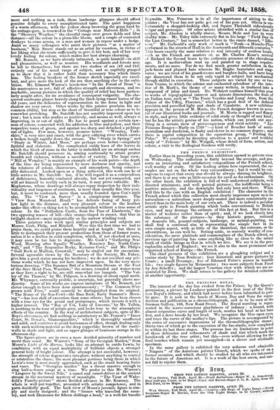THE FRENCH EXHIBITION.
Earlier than in preceding years, this exhibition opened to private view on Wednesday. The collection is fairly beyond the average, and pre- sents an interesting and satisfactory compendium of the French school, well worthy of study. Of the leading artists here represented, the ex- amples are not on the whole very extraordinary ; but it would be out- rageous to expect that every star should be always shining its brightest, and there is at any rate as little occasion for cavil as for enthusiasm. On the other hand, the exhibition is full of well understood subjects, well directed attainment, and well painted pictures; the indifferent being a positive minority, and the downright bad only here and there. When will this be the case with an English exhibition ? The character in the French school which this collection most clearly impresses upon us is its naturalism—a naturalism more deeply-seated and more consistently en- forced than in the main body of our own art. There is indeed a peculiar artistic style in French painting which looks conventional to British eyes, and may derange the estimate of this fact at first. But this is a matter of technics rather than of spirit ; and, if we look closely into the substance of the pictures—be they historic genre, national or domestic life, peasant-subjects, landscape, or animal-painting, we shall find a continual aim at representing the simple fact in its own simple aspect, with as little of the theatrical, the extreme, or the adventitious, as can well be. Setting aside, as scarcely worthy of con- sideration, the mere platitude and commonplace of the Dutch school, no previous age of painting has come anything like so close to the actual truth of visible things as that in which we live. We see it in the pre- raphaelite school of England ; we see it also in the most prominent and organized school of Europe—the French. The chief pictures of this exhibition are a ploughing subject and a canine study by Rosa Bonheur ; four historical and genre pictures by Comte ; a small. Decamps ; five of Edouard Frere's scenes in humble life ; two single figures by Meissonnier ; two more subjects from Faust by Ary Seheffer ; and the largest Venetian view with which we are ac- quainted by Ziem. We shall return to the gallery for detailed criticism at another opportunity.


























 Previous page
Previous page